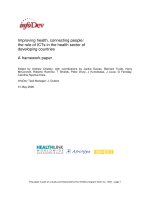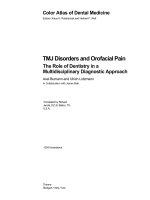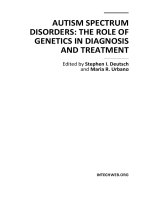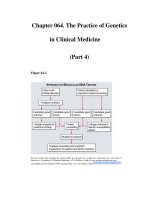THE ROLE OF SURGERY IN HEART FAILURE - PART 6 pdf
Bạn đang xem bản rút gọn của tài liệu. Xem và tải ngay bản đầy đủ của tài liệu tại đây (111.34 KB, 3 trang )
ventricular assist device support on myocardial
collagen content. Am J Surg 2000;180(6):498–501
[discussion: 501–2].
[105] Mital S, Loke KE, Addonizio LJ, et al. Left ven-
tricular assist device implantation augments nitric
oxide dependent control of mitochondrial respira-
tion in failing human hearts. J Am Coll Cardiol
2000;36(6):1897–902.
[106] Torre-Amione G, Stetson SJ, Youker KA, et al. De-
creased expression oftumornecrosis factor-alpha in
failing human myocardium after mechanical circu-
latory support: a potential mechanism for cardiac
recovery. Circulation 1999;100(11):1189–93.
[107] Loebe M, Gorman K, Burger R, et al. Complement
activation in patients undergoing mechanical circu-
latory support. ASAIO J 1998;44(5):M340–6.
[108] Dipla K, Mattiello JA, Jeevanandam V, et al. Myo-
cyte recovery after mechanical circulatory support
in humans with end-stage heart failure. Circulation
1998;97(23):2316–22.
[109] McCarthy PM, Nakatani S, Vargo R, et al. Struc-
tural and left ventricular histologic changes after
implantable LVAD insertion. Ann Thorac Surg
1995;59(3):609–13.
[110] Birks EJ, Latif N, Bowles C. Measurement of cyto-
kine levels and activation of the apoptotic pathway
in patients requiring left ventricular assist device
(LVAD): implication for timing of implantation.
Circulation 1999;99:2565–70.
[111] Dec GW, Fuster V. Idiopathic dilated cardio-
myopathy. N Engl J Med 1994;331:1564–75.
[112] Kopecky SL, Gersh BJ. Dilated cardiomyopathy
and myocarditis: natural history, etiology, clinical
manifestations, and management. Curr Probl Car-
diol 1987;12:573–647.
[113] Pauschinger M, Chandrasekharan K, Li J, et al.
Mechanisms of extracellular matrix remodeling in
dilated cardiomyopathy. Herz 2002;27:677–82.
[114] Maisch B. Ventricular remodeling. Cardiology
1996;87(Suppl 1):2–10.
[115] Maisch B. Extracellular matrix and cardiac intersti-
tium: restriction is not a restricted phenomenon.
Herz 1995;20:75–80.
[116] Frank JS, Langer GA. The myocardial interstiti-
um: its structure and its role in ionic exchange.
J Cell Biol 1974;60:586–601.
[117] Weber KT, Janicki JS, Shroff SG, et al. Collagen
remodeling of the pressure-overload, hypertro-
phied non-human primate myocardium. Circ Res
1988;62:757–65.
[118] Li J, Schwimmbeck PL, Tschope C, et al. Collagen
degradation in a murine myocarditis model: relevance
of matrix metallop roteinase in associat i on with inflam-
matory induction. Cardiovasc Res 2002;56:235–47.
[119] Spinale FG, Coker ML, Heung LJ, et al. A matrix
metalloproteinase induction/activation system
exists in the human left ventricular myocardium
and is upregulated in heart failure. Circulation
2000;102:1944–9.
[120] Gunja-Smith Z, Morales AR, Romanelli R, et al.
Remodeling of human myocardial collagen in idio-
pathic dilated cardiomyopathy: role of metallopro-
teinases and pyridinoline cross links. Am J Pathol
1996;148:1639–48.
[121] Spinale FG, Coker ML, Thomas CV, et al. Time-
dependent changes in matrix metalloproteinase ac-
tivity and expression during the progression of con-
gestive heart failure: relation to ventricular and
myocyte function. Circ Res 1998;82:482–95.
[122] Spinale FG, Coker ML, Krombach RS, et al. Ma-
trix metalloproteinase inhibition during developing
congestive heart failure: effects on left ventricular
geometry and function. Circ Res 1999;85:364–76.
[123] Ries C, Petrides PE. Cytokine regulation of matrix
metalloproteinase activity and regulatory dysfunc-
tion in disease. Biol Chem 1995;376:345–55.
[124] Chancey AL, Brower GL, Peterson JT, et al. Effects
of matrix metalloproteinase inhibition on ventricu-
lar remodeling due to volume overload. Circulation
2002;105:1983–8.
[125] Thomas CV, Coker ML, Zellner JL, et al. Increased
matrix metalloproteinase activity and selective
upregulation in LV myocardium from patients
with end-stage dilated cardiomyopathy. Circula-
tion 1998;97:1708–15.
[126] Diez J, Laviades C, Mayor G, et al. Increased
serum concentration of procollagen peptides in
essential hypertension. Relation to cardiac alter-
ation. Circulation 1995;91:1450–6.
[127] Querejeta R, Varo N, Lopez B, et al. Serum
carboxy-terminal propeptide of procollagen type I
is a marker of myocardial fibrosis in hypertensive
heart disease. Circulation 2000;101:1729–35.
[128] Poulsen SH, Høst NB, Jensen SE, et al. Relation-
ship between serum amino-terminal propeptide of
type III procollagen and changes of left ventricular
function after acute myocardial infarction. Circula-
tion 2000;101:1527–32.
[129] Jensen LT, H-Petersen K, Toft P, et al. Serum
aminoterminal type III procollagen peptide reflects
repair after acute myocardial infarction. Circula-
tion 1990;81:52–7.
[130] Høst NB, Jensen LT, Bendixen PM, et al. The
aminoterminal propeptide of type III procollagen
provides new information on prognosis after
acute myocardial infarction. Am J Cardiol 1995;
76:869–73.
[131] Sato Y, Kataoka K, Matsumori A, et al. Measuring
serum aminoterminal type III procollagen peptide,
7S domain of type IV collagen, and cardiac tropo-
nin T in patients with idiopathic dilated cardiomy-
opathy and secondary cardiomyopathy. Heart
1997;78:505–8.
[132] Klappacher G, Franzen P, Haab D, et al. Measur-
ing extracellular matrix turnover in the serum of
patients with idiopathic or ischemic dilated cardio-
myopathy and impact on diagnosis and prognosis.
Am J Cardiol 1995;75:913–8.
315
PATIENTS WHO HAVE DILATED CARDIOMYOPATHY
Patients Who Have Dilated Cardiomyopath y
Must Have a Trial of Bridge to Recovery:
The Case Against That Proposition
Philip A. Poole-Wilson, MD, FRCP, FMedSci
*
National Heart & Lung Institute, Imperial College London, London, UK
Propositions containing the word ‘‘must’’ are
usually mistaken and this proposition is no
exception.
In the last few years the management of patients
who have severe heart failure has increased in
complexity, requiring greater skills and finer judg-
ment from the physician and surgeon. New drugs
have emerged, the expertise of physicians in using
these drugs has improved, the indications for
cardiac transplantation have changed, new surgical
techniques have developed, and effective left ven-
tricular assist devices (LVADs) have become avail-
able. The newer LVADs are an engineering
triumph but raise critical issues regarding how
and when they should be used. This problem has
been exacerbated by the decline in the number of
patients undergoing transplantation, by the dearth
of donor hearts, and possibly by a growing public
aversion to cardiac transplantation.
Indications for the use of left ventricular
assist devices
The availability on the market of many devices
to assist the pumping function of the heart has
resulted in a new vocabulary. This has led to
a surplus of confusion, even misunderstanding,
extending from the characteristics and phenotypes
of patients and the indications for the use of
LVADs to the appropriate assessment of benefit,
if any.
The phrase ‘‘bridge to recovery’’ is used to
encapsulate the idea that doctors can identify
patients who have reversible cardiac dysfunction
and who only require transient support of the
circulation before spontaneous functional recov-
ery of the heart in situ. Established clinical entities
in which this can occur include acute myocarditis,
Takotsubo syndrome, acute alcohol ingestion, and
depression of cardiac function by toxins or drugs.
The phrase might also include patients who have
cardiogenic shock attributable to a second group
of patients who have myocardial infarction in
whom the likely outcome may be transformed. In
recent years several authors have possibly identi-
fied a third group in which a sizable proportion of
patients presenting with severe heart failure of
idiopathic origin and with large hearts (dilated
cardiomyopathy) do recover spontaneously.
These authors have argued that such patients
should receive a device pending a decision as to
whether to proceed to transplantation. The extent
to which this claim is correct is unknown largely
because many of these patients may in reality
belong to the other two groups of patients.
The phrases ‘‘destination treatment’’ or ‘‘life-
time therapy’’ are used to describe the intention at
the moment of insertion of the device: that it
should remain in place for the life of the patient
and that there is no intention to proceed to
transplantation. The first such device inserted
with this intention was reported in 2000 [1]. Since
then many patients around the world have re-
ceived devices of different designs, although the
efficacy remains somewhat uncertain [2,3].
* National Heart & Lung Institute, Imperial College
London, Dovehouse Street, London SW3 6LY, United
Kingdom.
E-mail address:
1551-7136/07/$ - see front matter Ó 2007 Elsevier Inc. All rights reserved.
doi:10.1016/j.hfc.2007.05.007 heartfailure.theclinics.com
Heart Failure Clin 3 (2007) 317–319
Cardiac Transplantation: Any Role Left?
Martin Cadeiras, MD, Manuel Prinz von Bayern, PhD,
Mario C. Deng, MD, FACC, FESC
*
College of Physicians and Surgeons, Columbia University, New York, NY, USA
Heart transplantation was introduced as
a breakthrough therapy that dramatically pro-
longed life in individually selected patients
thought to be near death. Unlike most other ther-
apeutic modalities, the survival benefit of cardiac
transplantation compared with conventional
treatment in advanced heart failure has never
been tested in a prospective randomized trial,
probably because the benefit of cardiac transplan-
tation compared with conventional therapy usu-
ally was assumed clinically evident. The early
experience at Stanford University Medical Center
between January 1968 and August 1976 demon-
strated overall 1- and 2-year survival rates of
52% and 43%, respectively, and a 90% return
to functional class I New York Heart Association
(NYHA) functional status among transplant sur-
vivors, most of them returning to their preillness
activities. In this initial series, 95% of the patients
selected for transplantation for whom donors did
not become available were dead 6 months after
evaluation. These data suggested that cardiac
transplantation probably not only prolonged sur-
vival, but could also return carefully selected re-
cipients to active lives [1]. In 1993, the 24th
Bethesda Conference on Cardiac Transplantation
recommended heart transplantation as the gold
standard therapy in selected patients who had re-
fractory advanced heart failure [2]. Ten years
later, according to the established Registry of
the International Society for Heart and Lung
Transplantation, more than 3000 new transplant
patients were being reported to the database
each year accounting for a total of 71,040 heart
transplants since it started in 1982 [3]. The early
observations of the Stanford group may not apply
today, because major changes on the understand-
ing and refinement of the therapeutic orchestra
available for patients in the advanced phase of
heart failure have occurred, specifically with the
introduction of highly specialized heart failure
units and comprehensive multidisciplinary teams;
new pharmacologic compounds, including angio-
tensin-converting enzyme (ACE) inhibitors, an-
giotensin-receptor blockers, spironolactone and
beta-blockers; novel devices, including trichamber
pacemakers, defibrillators, and mechanical circu-
latory support devices; and improved outcomes
with high-risk cardiac surgical procedures. Impor-
tant improvements in the evaluation of heart
transplant patients were achieved after the intro-
duction of functional capacity evaluation by mea-
suring oxygen consumption [4] and subsequently
a multivariate model to identify patients at highest
risk of death. The heart failure survival score was
derived from a prospective cohort and indepen-
dently validated allowing to dissect the referred
population into three groups with low-, medium-,
or high-risk profile [5]. Using this tool, a highly pro-
vocative national cohort study suggested that heart
transplantation may not confer a survival benefit
during the first year posttransplantation for pa-
tients having low- or medium-risk profiles [6,7].
These findings were supported by subsequent re-
ports using United Network for Organ Sharing
This work was supported at least in part by Grant
N HL 077096-01 from the National Institute of Health
(MPB, MCD) and by research Funds, Columbia
University, Division of Cardiology (MC).
* Corresponding author. Department of Medicine,
Division of Cardiology, College of Physicians & Sur-
geons, Columbia University, 622 West 168th Street,
PH12 STEM Room 134, New York NY 10032.
E-mail address:
(M.C. Deng).
1551-7136/07/$ - see front matter Ó 2007 Elsevier Inc. All rights reserved.
doi:10.1016/j.hfc.2007.04.004 heartfailure.theclinics.com
Heart Failure Clin 3 (2007) 321–347









